Molded Plastic Aspheric Lenses, Uncoated
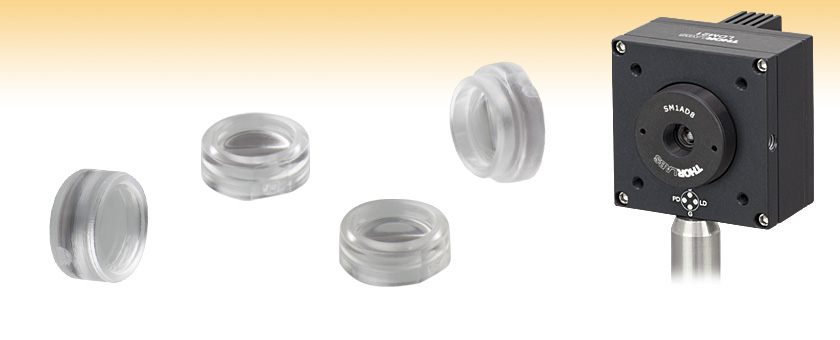
- Optical-Grade Plastic
- Designed for 670 nm or 785 nm
- Near Diffraction-Limited Performance
CAW100
CAW110
CAX100
CAY046
A Laser Diode is Collimated Using a
CAY046 Plastic Aspheric Lens in an
SM1AD8 Adapter Mounted to an LDM21
Laser Diode Mount

Please Wait
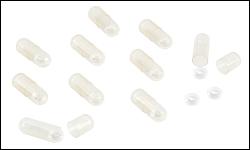
Click to Enlarge
Select aspheres are available in bulk at a discounted price. These items come prepackaged in capsules as shown here.
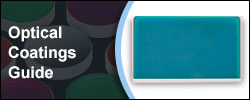
Features
- Material: Optical-Grade Plastic
- Outer Diameters of 5.20 mm, 6.28 mm, and 7.40 mm Available
- Effective Focal Lengths from 4.60 mm to 18.15 mm
- Individual and Packaged Options Available
Our Plastic Aspheric Lenses, which are available uncoated or with an antireflection coating for the 400 - 700 nm range, utilize molding technology to produce all-plastic optics. Designed by Philips for high-volume applications at affordable prices, these optics are ideal for low-power applications requiring lightweight components. The surface of the aspheric lens is designed to eliminate spherical aberration, which allows for the spot size and collimation of a monochromatic beam of light to approach the diffraction limit. All our plastic aspheric lenses are available individually. Select lenses are also offered in packages of 25, 50, or 100 pieces at a discount of 16%, 33%, and 50%, respectively, over the individual lens price.
In laser diode systems, difficulties with aberration correction are compounded by the beam's high divergence angle. Since individual spherical lenses can refract light at only small angles before spherical aberration is introduced, multiple elements are often required to collimate laser diode light. In contrast, a single aspheric lens collimates without introducing spherical aberration. When used to collimate or focus light, the lens should be oriented so that the side with a larger radius of curvature (i.e., the flatter surface) faces the point source.
Conversely, when coupling into fiber, it is often necessary to focus the laser light to a near-diffraction-limited spot. With single spherical elements, spherical aberration, rather than diffraction limit, serves as the limiting factor to achieving such a small spot size. The diffraction-limiting design of these aspheric lenses helps to minimize spherical aberration, allowing the focal spot size to approach the diffraction limit.
All of the plastic aspheric lenses on this page are corrected for the presence of a window, like the window in TO-type laser packages. Please see the Specs tab for details. Additionally, the side of each lens has a flat indent that provides a reference location.
| Item # | CAY046 | CAW100 | CAX100 | CAW110 | CAX183 |
|---|---|---|---|---|---|
| Effective Focal Length | 4.60 mm | 9.85 mm | 10.0 mm | 10.92 mm | 18.15 mm |
| Numerical Aperture | 0.40 | 0.195 | 0.2 | 0.19 | 0.12 |
| Clear Aperture | Ø3.7 mm | Ø3.4 / Ø3.9 mm (S1 / S2)c |
Ø4.1 mm | Ø4.1 mm | Ø4.3 mm |
| Working Distancea | 3.00 mm | 4.69 mm | 8.48 mm | 9.33 mm | 16.30 mm |
| Outer Diameter | 7.40 mm | 5.20 mm | 6.28 mm | 6.28 mm | 6.28 mm |
| Center Thickness | 2.70 mm | 2.52 mm | 1.25 mm | - | 1.09 mm |
| Wavefront Error, On Axisb (RMS) | 0.040λ | 0.040λ | 0.080λ | 0.040λ | 0.030λ |
| Wavefront Error, Totalb (RMS) | 0.070λ | 0.050λ | 0.090λ | 0.055λ | 0.035λ |
| Surface Quality | 80-50 Scratch-Dig | ||||
| Material | Acrylic | Cyclic Olefin Copolymer | Polycarbonate | Cyclic Olefin Copolymer | Polycarbonate |
| Design Wavelength | 670 nm | 785 nm | 670 nm | 670 nm | 670 nm |
| AR Coating Wavelength (>95% Transmission) |
None | ||||
| Laser Window Correction | 0.25 mm (N-BK7) | 5 mm (N-SF11) | 0.25 mm (N-BK7) | 0.25 mm (N-BK7) | 0.25 mm (N-BK7) |
| Operating Temperature | 5 to 65 °C | 0 to 65 °C | 0 to 65 °C | -10 to 75 °C | -10 to 75 °C |
| Storage Temperature | -10 to 70 °C | 0 to 65 °C | 0 to 65 °C | -25 to 100 °C | -25 to 100 °C |
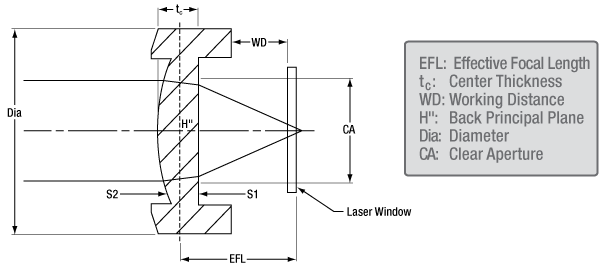
Please note the effective focal length is determined from the back principal plane, which does not coincide with the flat surface of the lens.
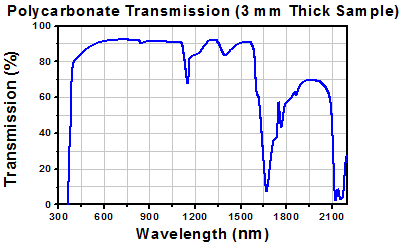
Click to Enlarge
The transmission curve above shows total transmission through polycarbonate, including surface reflections. Our CAX100 and CAX183 plastic aspheric lenses are fabricated from this material.
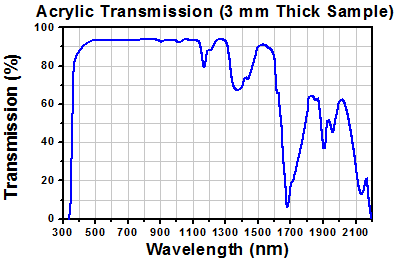
Click to Enlarge
The transmission curve above shows total transmission through acrylic, including surface reflections. Our CAY046 plastic aspheric lens is fabricated from this material.
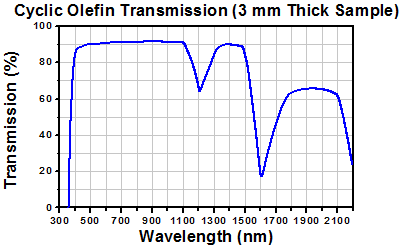
Click to Enlarge
The transmission curve above shows total transmission through cyclic olefin copolymer, including surface reflections. Our CAW100 and CAW110 plastic aspheric lenses are fabricated from this material.
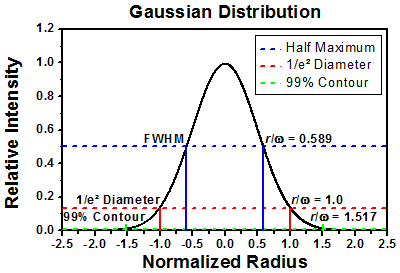
The graph shows a plot of the intensity distribution of a Gaussian beam with common methods of defining the beam diameter. For Gaussian calculations the 1/e2 diameter is used. The intensity of a Gaussian beam is given by:

Where I(r) is the radial intensity of the beam, Io is the on-axis intensity, r is the radial distance, and ω is the radius of the beam where I(r) falls to 1/e2. To focus collimated laser light into a single mode fiber, the 1/e2 radius at the beam waist (focal point of the beam) should be equal to half the mode field diameter of the fiber. For a M2 = 1 beam, select a lens with a focal length, f, determined using:

where λ is the wavelength of the light, D is the 1/e2 diameter of the beam incident on the lens, and ωo is the radius at the beam waist.
| Posted Comments: | |
Sylvain Meunier
(posted 2023-10-20 15:07:35.66) Hello,
Is it possible to get Zemax model of this product ?
Thanks
S. Meunier cdolbashian
(posted 2023-10-27 11:58:11.0) Thank you for reaching out to us with this inquiry! These lenses are already in the lens catalogue within Zemax software! I have contacted you directly to show you where they can be found. fcouweleers
(posted 2016-11-08 13:06:35.227) the OpticStudio description of this lens (available from the Philips lens catalogue in OpticStudio) does not match your description. more specifically: the working distance appears to be specified from the wrong plane.
can you confirm this discrepancy? tfrisch
(posted 2016-11-10 10:37:23.0) Hello, I have contacted you directly to discuss the model and the various planes. It is important to define working distance as either the distance to the laser window that it would collimate or the distance to the focal point. jlow
(posted 2012-10-02 11:45:00.0) Response from Jeremy at Thorlabs: I will send you a transmission graph via e-mail for the polycarbonate material used in the plastic aspheric lenses. benjamin.hoetzer
(posted 2012-10-02 13:54:07.0) Hello, I am looking for a Plastic Aspheric Lens that can be used for light between 460 and 530 nm. Are there any products available?
The lenses CAW100, CAW110 and CAX100 are said to be ok for 670 and for 785 nm, how much transmittance do they show for light between 460 and 530 nm?
Thanks for your answer. jjurado
(posted 2011-05-17 13:22:00.0) Response from Javier at Thorlabs to John_B_Lee: Thank you very much for contacting us with your request. The effective focal length of a lens is generally measured from the principal plane (or planes) of the lens, which is a hypothetical plane, where all the light refraction is considered to happen. Consequently, it is more useful to use the back focal length (BFL) in practical applications. This is defined as the distance from the back surface of the lens to the focal point. For the CAY046, the BFL is 3.18 mm. John_B_Lee
(posted 2011-05-16 14:44:23.0) The CA specs show a diagram but the actual position of the efl is not clear. Exactly where is the Effective focal length measured from (specifically CAY046)? tor
(posted 2011-01-10 16:12:54.0) Response from Tor at Thorlabs to Roger: These lenses can be cleaned with a solution of green soap (available at a pharmacy) in water (several drops of soap per 100 cc of water is acceptable). The lenses would need to be rinsed off in water and then alcohol to aid in drying. rogerj
(posted 2010-12-16 16:14:40.0) Currently am using the CAY046 and having issues when they get dirty. Do you have any suggestions on how to clean them. I am afraid to use anything too strong that will damage them. Roger Johnson apalmentieri
(posted 2009-12-22 13:33:52.0) A response from Adam at Thorlabs: We are currently looking over the graphs to determine their validity. Based on some initial Zemax simulations for the off axis performance, we have been able to reproduce similar curves that exhibt the behavior represented in the current online graphs. It is our understanding that the longer focal length lenses will provide the better imaging performance. The longer focal length lenses typically exhibit less spherical aberrations since the angle between the chief ray and the optical axis is smaller. I would also like to point out that this is an aspheric lens and should not be compared to a basic lens design. Based on our initial Zemax simulations of the Tilt sensitivity, it does seem that the scaling should be tenth of a degree, not a full degree. Since these simulations are based heavily upon initial conditions, we are looking into this further and hope to update the web soon. I will email you with the simulated curves. dschaack
(posted 2009-12-21 18:10:17.0) Likely errors in the data for CAY033 and CAY046:
I believe that the "On-axis Performance" and "Lens Tilt Sensitivity" curves have been reversed for these two lenses.
I have tried to reverse-engineer the designs of these lenses from these performance curves and I find that I can do it if I reverse the curves, but not if I use the curves the way that you present them.
Consider this: according to your curves, the longer focal length lens has much better imaging performance than does the shorter focal length lens. This is non-physical; it is always easier to provide a given level of performance with a shorter focal length lens (assuming the same basic design and focal ratio of the lenses).
In addition to the curves being reversed, I believe that the tilt angle scale is incorrect. What you call the tilt angle in degrees is actually the tilt angle in _tenths_ of a degree. Consider it this way: if the tilt sensitivity were actually as low as you show it, then it would also be the case that the performance as a function of field radius would also be much better than you show it. klee
(posted 2009-07-22 17:01:46.0) A response from Ken at Thorlabs to hkww: The transmittance is >85% at 405nm. hkww
(posted 2009-07-22 16:04:54.0) Hi! I would like to use plastic aspheric lenses to focus light at 405nm. Please inform me about transmission coefficient for this wavelength. best regards, Vadim Kiyko. jens
(posted 2009-06-11 08:22:19.0) An answer from Jens at Thorlabs: the plastic material transmission is basically the same up to about 1100nm and down to about 450nm. You only have to take into account that performance with repsect to other parameters might be different than shown in the spec table since those values are based on the design wavelenght. Please let me know if you need additional information. Mario.Stipcevic
(posted 2009-06-11 06:15:32.0) Hi !
I have a question about CAY046. I would like to use this lens to focus light at 830nm. I am not interewsted in a very good focusing performance just whether this type of plastic is transparent at this wavelength. I see non data about the transmission coefficient versus wavelenght, can you help me?
Best regards,
Mario Stipcevic |
 Products Home
Products Home










 Plastic Aspheres: Uncoated 80-50 Scratch-Dig
Plastic Aspheres: Uncoated 80-50 Scratch-Dig